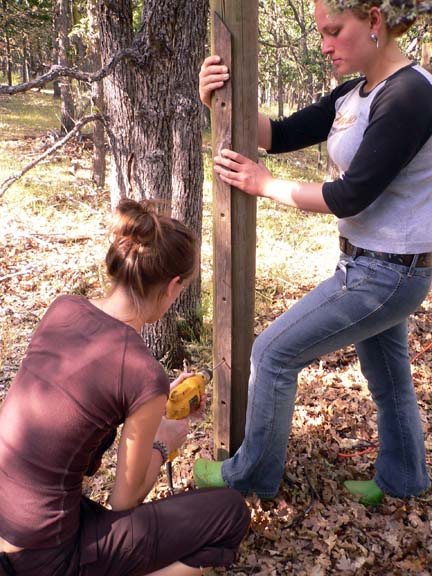Cribbing the Corner
Anchoring the fourth run
The great work done by Jacki and Jannel in getting the loafing pen ready to hold sheep has been a great incentive to extend the fence so that more of the area set aside as the sheep's summer home can be made accessible. Eventually there will be six legs to the network of fencing that will form the loafing pen, four to form the perimeter, and two to break the pen up into three separate areas.
Jannel drills wire holes while Jacki holds the template
 |
| |
The loafing pen covers more than two acres, land that is partly shaded slopes and partly damp low-ground with the result that we'll need to seed different areas with the appropriate forage such as orchard grass for the shady parts and timothy for the wetter parts. The internal fencing will allow us to shift the sheep from area to area so that they don't over graze any particular area. Grasses grow from the tip of the blade, and the plants need to be left alone while they're putting on their bulk. If the tips keeps getting nibbled on, the forage doesn't do very well.
The three legs already brought on line form a large triangle; the next step is expand that triangle into a much larger rectangle by adding two more legs: Leg Four which will run east/west along Windward Lane, and Leg Five which will run north-south from Windward Lane to the hay barn.
The western part of Leg Four is relatively easy digging -- lots of topsoil and not many rocks, but the eastern end is an entirely different matter because once you dig through six to nine inches of topsoil, you're looking at solid bedrock basalt.
By use of picks, hammers and such we're able to use surface fractures break up the basalt and get down to about a foot below the surface, but after that, it's just too hard and too solid to do much with.
you can see the standard two-tie end brace on the right
 |
| |
Each end of a fence run has to be able to withstand the considerable stress involved in keeping the fence wire taunt over a run a more than two hundred feet. The usual way we do that is to create a brace by sinking two railroad ties into the ground at least thirty inches, filling in the post holes with concrete, and building a triangulated brace. In the pic below, you can see the brace t the western end of Leg Four.
Since we're not going to be able to sink holes for the railroad ties deep enough to do the job, the alternative is to create a crib which involves placing four posts as deep as we can, creating a concrete shoulder to give them as much support as we can, and then building an internal box out of treated lumber (called a "crib") and filling it full of big rocks so that the combined mass of the structure is able to resist the tension that will be created when we tighten the six ratchets that tune the wire.
Jillian and Virgil appling a release coating to the form
that will collar the section of telephone pole
 |
| |
And just to make things a bit more complicated, the crib needs to be a parallelagram instead of the usual square since the angle formed between Leg Four and Leg Five isn't the usual ninety degrees, but something more along the lines of seventy-five degrees. To accommodate that, we went with four sections of telephone pole instead of the usual railroad ties.
Once the sections of telephone pole are cemented into place, we'll notch them to take the crib slats -- more work, but it'll be right, it'll do the job and it will last.
Notes From Windward - Index - Vol. 66
|


